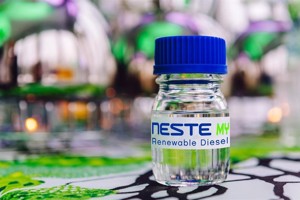Neste and New Jersey Natural Gas target reducing greenhouse gas emissions with Neste MY Renewable Diesel
Neste and New Jersey Natural Gas, the principal subsidiary of New Jersey Resources, look to reduce greenhouse gas emissions with Neste MY Renewable Diesel. Expanding on its sustainability leadership, NJNG announced it is switching its medium-duty trucks and associated equipment to renewable diesel to help reduce GHG emissions. NJNG is now the first natural gas utility on the East Coast to use this cleaner fuel for its fleet operations.
“We are excited to help New Jersey Natural Gas reduce their fleet emissions with renewable diesel. Innovative companies, like NJNG, are paving the way towards a larger-scale transition to renewables and a cleaner energy future,” says Carrie Song, Senior Vice President, Commercial, Renewable Products at Neste. “This partnership demonstrates the increasing demand for lower-emission fuels across the entire nation. We look forward to helping other businesses in the state effectively reduce greenhouse gas emissions.”
When using Neste MY Renewable Diesel – made from sustainably sourced, 100% renewable raw materials – GHG emissions can be reduced by up to 75%* over the fuel’s life cycle compared to fossil diesel. Additionally, since Neste’s renewable diesel is compatible with all diesel engines, NJNG is able to seamlessly transition to this fuel without the need for new infrastructure or investment into fleet modifications.
Approximately 70 medium-duty trucks in NJNG’s fleet now run on renewable diesel. These vehicles will account for over 57,000 gallons (168 tons) of renewable diesel which can help reduce GHG emissions by up to 550 tons* annually compared to the use of fossil diesel. It equals the annual direct GHG emissions from more than 120** passenger vehicles according to the EPA Greenhouse Gas Equivalencies Calculator.
“Innovation and new technologies will be critical to reduce emissions economywide and reach New Jersey’s climate goals. New Jersey Natural Gas’ use of renewable diesel to help reduce our fleet emissions is the next step toward this goal,” said Patrick Migliaccio, Senior Vice President and COO of New Jersey Natural Gas. “Together with Neste and KW Rastall, our fuel supplier, we are helping lower transportation related emissions in New Jersey.”
Collaboration with industry’s leading fuel distributors
Testing and the delivery of Neste MY Renewable Diesel is made possible by Neste’s long-term distributor Diesel Direct, the nation’s largest mobile on-site fueling company, and their partnership with KW Rastall Oil, NJNG’s fuel supplier. Since 2018, Diesel Direct has been distributing Neste MY Renewable Diesel to hard-to-abate industries in the U.S., including road transportation, construction, agriculture, marine sector and more. Replicating its value chain in New Jersey, Neste supports the state’s goal to reduce GHG emissions from transportation.
In addition to reducing GHG emissions, Neste MY Renewable Diesel is the first TOP TIER™ renewable diesel fuel certified for its high quality. It can be used in its neat form or blended with fossil diesel at any ratio. It also performs well in extreme cold conditions and can be stored over long periods of time without deterioration, making it an ideal choice for NJNG.
Neste is increasing its annual production capacity to 1.9 billion gallons (5.5 million tons) of renewable products globally in 2024. Neste was one of the first companies to supply renewable diesel to states on the West Coast, including California and Oregon, and the company is rapidly expanding its production, fueling station network, and distribution capabilities to meet the growing demand across the U.S.
*) The GHG emission reduction percentage varies depending on the region-specific legislation that provides the methodology for the calculations (e.g. EU RED II 2018/2001/EU for Europe and U.S. California LCFS for the U.S.), and the raw material mix used to manufacture the product for each market.
**) EPA Greenhouse Gas Equivalencies Calculator







Comments